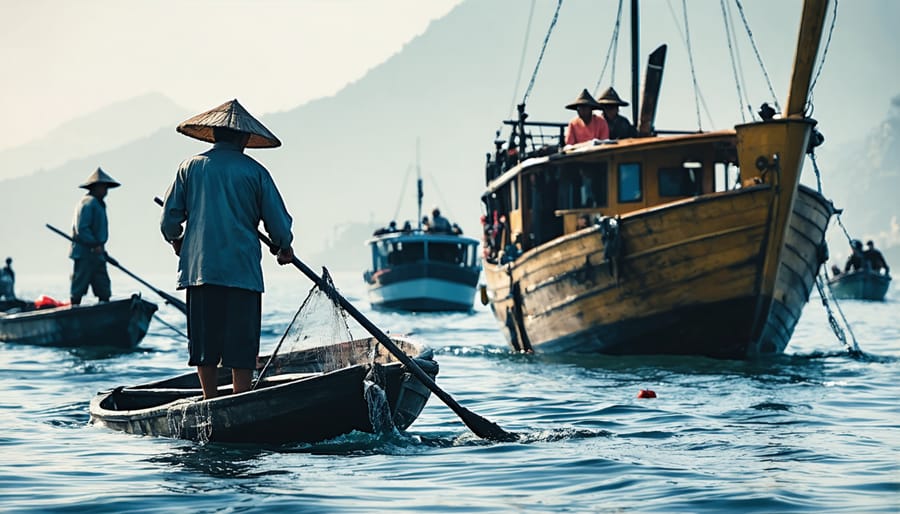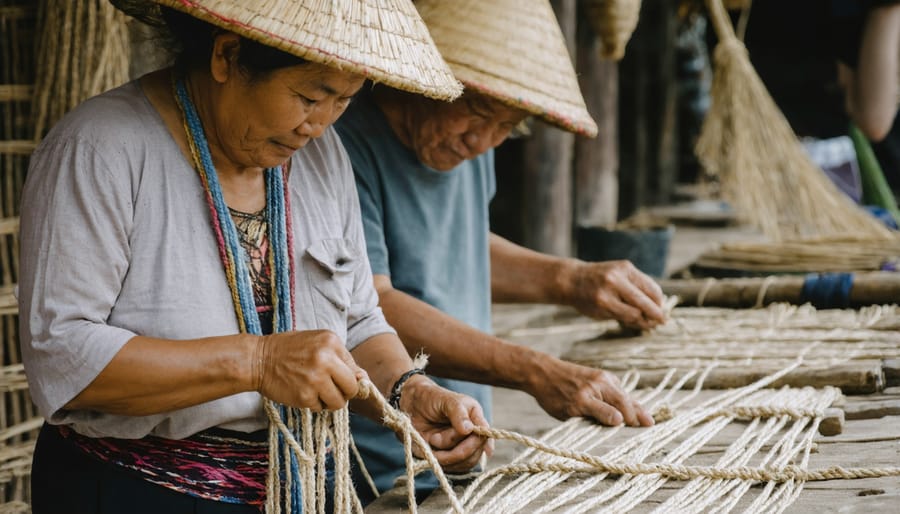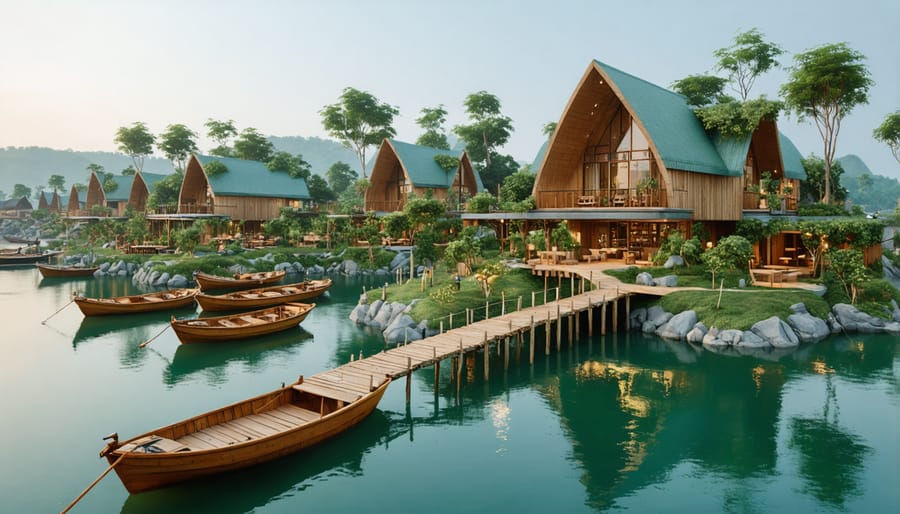
Along the world’s coastlines, generations of maritime communities have woven their lives into the rhythm of the tides, creating a rich tapestry of coastal cultural identity that shapes our relationship with the sea. From the weathered hands of fishermen mending nets at dawn to the time-honored rituals of seafaring festivals, these traditions form the backbone of coastal heritage worldwide. Yet today, these communities stand at a critical crossroads, balancing centuries-old practices with the demands of modern tourism and environmental challenges. Their story is not merely one of preservation but of remarkable adaptation, as ancient fishing techniques evolve alongside sustainable tourism practices, and traditional ecological knowledge guides marine conservation efforts. This delicate dance between past and present offers vital lessons in cultural resilience, environmental stewardship, and the art of maintaining authenticity in an ever-changing world.
The Evolution of Coastal Communities
Traditional Maritime Practices
Traditional coastal communities have developed sophisticated fishing methods over generations, carefully attuned to local marine ecosystems and seasonal patterns. Hand-line fishing, trap setting, and net casting remain vital practices, with specific techniques varying by region and target species. These methods often demonstrate remarkable sustainability, as traditional fishers understand the importance of maintaining fish populations for future harvests.
Navigation techniques passed down through generations combine practical seamanship with deep environmental knowledge. Traditional mariners read weather patterns through cloud formations, wind direction, and bird behavior. They navigate using natural markers like coastal landmarks, star positions, and ocean current patterns, skills that continue to complement modern GPS technology.
Cultural practices surrounding maritime activities often involve elaborate ceremonies and rituals. Before setting sail, many communities perform blessing ceremonies for vessels and crew members. Fish processing and preservation methods, such as salt-curing and sun-drying, represent important cultural knowledge that has sustained coastal communities for centuries. These traditions often incorporate sustainable practices that minimize waste and maintain the delicate balance between human needs and marine resource conservation.

Modern Tourism’s Impact
The surge in coastal tourism has brought both opportunities and challenges to traditional maritime communities. Local fishing practices, once the backbone of coastal economies, now compete with tourist activities for access to prime waterfront locations. Many traditional fishing harbors have been transformed into luxury marinas, while ancestral fishing grounds face increased pressure from recreational boating and water sports.
Tourism has also influenced traditional craft-making and seafaring skills. While some communities have successfully adapted by incorporating these traditions into tourist experiences, others struggle to maintain authenticity. Local artisans now often modify traditional designs to appeal to tourist preferences, leading to a gradual shift away from historical practices.
However, the tourism industry has also created opportunities for preserving coastal heritage. Cultural tourism initiatives have helped fund the restoration of historic fishing vessels and traditional boatyards. Some communities have developed successful programs where visitors can experience traditional fishing methods or learn about maritime crafts, generating income while keeping ancient practices alive.
The key challenge lies in finding a balance between economic development and cultural preservation, ensuring that tourism supports rather than supplants coastal traditions.
Cultural Exchange Through Marine Tourism
Educational Tourism Programs
Educational tourism programs along coastal regions have emerged as vital bridges between traditional maritime heritage and modern conservation efforts. These initiatives offer immersive experiences where visitors can learn firsthand about fishing techniques, boat building, and seafaring customs that have been passed down through generations.
Many coastal communities now host interactive workshops where traditional fishermen demonstrate net-mending techniques and share stories about sustainable fishing practices. Visitors can participate in hands-on activities like traditional rope-making, navigation using ancient methods, and learning about the relationship between lunar cycles and fishing patterns.
Marine education centers have developed specialized programs that combine cultural heritage with environmental awareness. Students and tourists can join guided tours led by local elders who explain how their communities have historically maintained balance with marine ecosystems. These programs often include practical demonstrations of traditional conservation methods, such as rotating fishing grounds and seasonal harvesting practices.
Some notable initiatives include “Living Coast” programs, where participants spend time with fishing families, learning about their daily routines and traditional ecological knowledge. Culinary workshops teach traditional seafood preparation methods while emphasizing the importance of sustainable harvesting. Youth-focused programs particularly help ensure these traditions continue by connecting younger generations with their maritime heritage.
These educational initiatives not only preserve cultural knowledge but also promote sustainable tourism practices that benefit both visitors and local communities.

Local Community Involvement
Local communities along coastlines worldwide have found innovative ways to embrace tourism while preserving their cultural heritage. Through carefully managed initiatives focused on coastal community preservation, residents actively participate in sharing their maritime traditions with visitors while maintaining control over tourism development.
Many coastal towns have established community-led tourism cooperatives, where local fishermen offer authentic fishing experiences, traditional boat-building demonstrations, and guided tours of historic harbors. These initiatives provide supplementary income while ensuring traditional practices remain viable and respected.
Local artisans and craftspeople benefit from dedicated marketplaces where they can showcase and sell traditional maritime crafts, from rope-making to boat model construction. Cultural centers, often managed by community elders, offer workshops on traditional navigation techniques, weather reading, and local folklore, creating meaningful connections between visitors and residents.
Young community members are increasingly involved through apprenticeship programs that combine traditional knowledge with modern tourism management skills. This approach ensures the transfer of cultural practices to new generations while creating sustainable employment opportunities.
The success of these community-based initiatives demonstrates how tourism can support rather than supplant traditional coastal ways of life, providing economic benefits while preserving cultural identity and environmental stewardship practices that have sustained these communities for generations.
Preserving Maritime Heritage
Conservation Initiatives
Across coastal regions worldwide, communities are implementing innovative programs to protect their cultural heritage while addressing environmental challenges. Local initiatives focusing on maritime heritage preservation work alongside environmental conservation efforts, creating a holistic approach to coastal protection.
The Sea Guardian Program, launched in 2018, exemplifies this dual-purpose conservation model. Local fishermen collaborate with marine biologists to monitor fish populations while documenting traditional fishing practices. This knowledge-sharing initiative has successfully preserved centuries-old fishing techniques while establishing sustainable harvest limits.
Community-led projects like the Coastal Culture Archive are digitizing oral histories, traditional navigation methods, and indigenous ecological knowledge. These valuable resources help younger generations maintain their connection to coastal traditions while informing modern conservation strategies.
Educational programs in coastal schools now incorporate traditional ecological knowledge into their marine science curriculum. Students learn about historical fishing practices, traditional weather prediction methods, and sustainable resource management from community elders.
Volunteer networks play a crucial role in these initiatives, with local residents and tourists participating in beach cleanups, coral restoration projects, and cultural heritage documentation. These programs demonstrate how environmental conservation and cultural preservation can work hand in hand, ensuring coastal traditions continue to thrive while protecting marine ecosystems for future generations.
Sustainable Tourism Practices
Sustainable tourism practices play a vital role in preserving coastal traditions while allowing visitors to experience and appreciate maritime heritage. Communities have developed innovative approaches to balance economic benefits with cultural preservation, implementing visitor management systems that limit daily tourist numbers and establishing designated viewing areas for traditional fishing demonstrations.
Many coastal communities now offer immersive educational programs where visitors can learn traditional fishing techniques, boat-building skills, and local crafts from community elders. These programs generate income while ensuring knowledge transfer to younger generations. Local guides, often from fishing families, lead cultural tours that share authentic stories and experiences rather than staged performances.
Environmental considerations are equally important, with communities implementing strict guidelines for tour operators. These include using traditional fishing vessels for tourism activities, maintaining proper distance from active fishing areas, and following waste management protocols. Some regions have established community-led marine protected areas where traditional fishing practices continue alongside carefully managed tourism activities.
Successful models include the development of heritage centers that serve both as educational facilities and community gathering spaces. These centers often feature interactive exhibits, workshops, and seasonal festivals that celebrate local traditions while providing economic opportunities for residents. Revenue sharing schemes ensure that tourism benefits are distributed throughout the community, supporting both traditional livelihoods and conservation efforts.

Future of Coastal Traditions
Innovation in Cultural Tourism
Cultural tourism along coastal regions is undergoing a remarkable transformation, blending time-honored traditions with innovative preservation methods. Many coastal communities now utilize digital storytelling platforms to share their maritime heritage, allowing visitors to experience local customs through interactive mobile apps and augmented reality experiences. These technological solutions help preserve oral histories, traditional fishing techniques, and ancient navigation methods for future generations.
Innovative eco-cultural tours have emerged, where local fishermen serve as guides, sharing their knowledge while demonstrating sustainable fishing practices. These experiences often include hands-on activities like net mending, traditional boat building, and seafood preparation using ancestral methods. Such immersive programs not only generate income for local communities but also ensure the transmission of cultural knowledge.
Museums and cultural centers are reimagining their roles through living history programs, where visitors can participate in traditional activities under the guidance of community elders. Some coastal towns have established “heritage harbors,” where traditional vessels are maintained and used for educational purposes, creating floating classrooms that combine historical learning with practical seamanship.
Community-led initiatives have also introduced creative solutions for managing tourism impact. Many regions now implement visitor capacity limits and rotating access to sensitive cultural sites, ensuring preservation while maintaining authentic experiences. Local artisans are finding new markets through online platforms, allowing them to maintain traditional crafts while reaching global audiences.
These innovations in cultural tourism demonstrate how coastal communities can preserve their heritage while adapting to modern demands, creating sustainable economic opportunities that honor and protect traditional ways of life.
Community-Led Initiatives
In recent years, coastal communities have taken decisive steps to maintain authenticity in their cultural presentation, developing grassroots programs that protect traditional practices while engaging with modern tourism. Local fishing families have established heritage cooperatives, ensuring their centuries-old techniques and knowledge are shared accurately with visitors. These initiatives, often integrated with broader community health initiatives, help preserve the genuine character of maritime regions.
Many communities have created cultural councils led by longtime residents and indigenous representatives, who oversee tourism development and ensure it aligns with local values. These councils review proposed attractions, evaluate tour operator practices, and develop guidelines for responsible cultural tourism. For instance, the Maritime Heritage Network in Nova Scotia connects multiple coastal villages, allowing them to share resources and maintain consistent standards for cultural presentation.
Local artisans and tradition bearers have also organized workshops and apprenticeship programs, passing down skills like net-making, boat building, and traditional navigation to younger generations. These programs serve the dual purpose of preserving cultural knowledge and creating authentic experiences for visitors. Some communities have established cultural centers where residents control the narrative of their maritime heritage through carefully curated exhibits and demonstrations.
Digital preservation efforts, led by community elders and local historians, document oral histories, traditional fishing methods, and seasonal celebrations. These archives ensure that future generations and visitors alike can access accurate representations of coastal traditions, even as communities continue to evolve and adapt to changing times.
The delicate balance between preserving coastal traditions and embracing tourism development represents one of the most significant challenges facing maritime communities today. As we’ve explored throughout this article, coastal traditions are not merely relics of the past but living cultural heritage that continues to shape community identity and environmental stewardship. Successfully integrating these traditions with modern tourism requires thoughtful planning, community engagement, and a commitment to sustainable practices.
Communities that have found success in this balance often employ a three-pronged approach: preserving traditional fishing and maritime practices, developing responsible tourism infrastructure, and creating educational opportunities that benefit both locals and visitors. This approach ensures that economic growth through tourism doesn’t come at the expense of cultural authenticity or environmental health.
Looking ahead, the future of coastal communities lies in their ability to adapt while maintaining their core identity. Innovative solutions, such as cultural tourism programs led by local fishermen, traditional craft workshops, and community-based conservation initiatives, demonstrate how tradition and tourism can strengthen rather than oppose each other.
The key to sustainable coastal tourism development lies in viewing traditional practices not as obstacles to progress but as valuable assets that enhance the visitor experience while preserving local heritage. By maintaining this perspective, coastal communities can create a future where economic prosperity and cultural preservation work hand in hand, ensuring that future generations can experience and appreciate these unique maritime traditions.
jessica
Ava Singh is an environmental writer and marine sustainability advocate with a deep commitment to protecting the world's oceans and coastal communities. With a background in environmental policy and a passion for storytelling, Ava brings complex topics to life through clear, engaging content that educates and empowers readers. At the Marine Biodiversity & Sustainability Learning Center, Ava focuses on sharing impactful stories about community engagement, policy innovations, and conservation strategies. Her writing bridges the gap between science and the public, encouraging people to take part in preserving marine biodiversity. When she’s not writing, Ava collaborates with local initiatives to promote eco-conscious living and sustainable development, ensuring her work makes a difference both on the page and in the real world.
